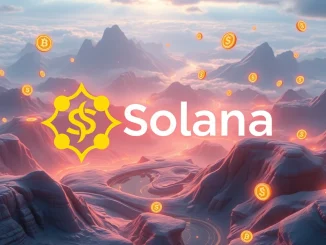
Exciting news is buzzing in the Decentralized Finance (DeFi) space! Treehouse Finance, a pioneering platform focused on bridging traditional finance with the innovative world of DeFi, has just announced a significant milestone. They’ve successfully raised fresh capital, propelling their valuation to a staggering $400 million. This funding injection is set to fuel the expansion of their groundbreaking DeFi bond platform and further develop their suite of fixed-income solutions. Are you ready to dive into how Treehouse Finance is poised to reshape the future of finance?
Treehouse Finance Funding: A $400M Vote of Confidence
Let’s break down this exciting development. Treehouse Finance funding round, structured as a simple agreement for future tokens (SAFT), signals strong investor confidence in their vision. A $400 million valuation is no small feat, especially in the rapidly evolving DeFi landscape. This financial boost will be instrumental in scaling their operations and enhancing their platform’s capabilities. But what exactly does Treehouse Finance do, and why is this funding so significant?
Unlocking the Potential of DeFi Fixed Income
At its core, Treehouse Finance is tackling a massive opportunity: the $600 trillion traditional bond market. They aim to bring the stability and predictability of fixed income to the often-volatile DeFi world. How? By creating a robust and reliable DeFi fixed income platform. Imagine a world where you can access bond-like instruments with the transparency and efficiency of blockchain technology. That’s the promise Treehouse Finance is delivering.
Here’s what makes their approach so compelling:
- Bridging TradFi and DeFi: Treehouse Finance is building a bridge between the established world of traditional finance and the disruptive potential of DeFi. This is crucial for attracting institutional investors and mainstream adoption.
- Focus on Fixed Income: While DeFi is often associated with high-yield, high-risk opportunities, Treehouse Finance is carving out a niche in fixed income, offering more stable and predictable investment options.
- Innovation in Benchmark Rates: They are introducing Decentralized Offered Rates (DOR), aiming to establish benchmark interest rates for DeFi fixed-income products, similar to LIBOR in traditional finance.
What are Decentralized Offered Rates (DOR)?
Let’s delve deeper into Decentralized Offered Rates (DOR). In traditional finance, benchmarks like LIBOR (London Interbank Offered Rate) play a crucial role in setting interest rates for various financial products. Treehouse Finance is pioneering a similar concept for DeFi, but with a decentralized twist.
Why are DOR important for DeFi?
- Transparency and Reliability: Decentralized rates are designed to be more transparent and less susceptible to manipulation compared to centralized benchmarks.
- Foundation for DeFi Fixed Income: DOR can serve as a foundational benchmark for pricing and valuing various DeFi fixed-income instruments, making the market more efficient and accessible.
- Attracting Institutional Capital: Having reliable benchmarks is essential for attracting institutional investors who are accustomed to such frameworks in traditional markets.
Tokenized Assets (tAssets): Expanding DeFi Horizons
Another key aspect of Treehouse Finance’s strategy involves tokenized assets (tAssets). Tokenization is the process of representing real-world assets on a blockchain. In the context of Treehouse Finance, this likely refers to tokenizing traditional fixed-income instruments, making them accessible within the DeFi ecosystem.
Benefits of Tokenized Assets in DeFi:
| Benefit | Description |
|---|---|
| Increased Liquidity | Tokenized assets can be traded 24/7 on decentralized exchanges, potentially leading to higher liquidity compared to traditional bond markets. |
| Fractional Ownership | Tokenization allows for fractional ownership of assets, making fixed-income investments more accessible to smaller investors. |
| Efficiency and Speed | Blockchain technology enables faster settlement and reduced administrative overhead compared to traditional bond transactions. |
| Transparency | Transactions and ownership are recorded on a public blockchain, enhancing transparency and reducing counterparty risk. |
Challenges and the Road Ahead
While Treehouse Finance’s vision is compelling, the journey to revolutionize the $600 trillion bond market won’t be without its challenges. Navigating regulatory landscapes, ensuring security and scalability, and educating users about DeFi fixed income are crucial hurdles to overcome.
Key Challenges:
- Regulatory Uncertainty: DeFi is still a relatively new and evolving space, and regulatory frameworks are still being developed worldwide.
- Security Risks: Smart contract vulnerabilities and security breaches remain a concern in the DeFi space. Robust security measures are paramount.
- User Education: DeFi can be complex for newcomers. Educating users about the risks and benefits of DeFi fixed income is essential for wider adoption.
- Competition: The DeFi space is becoming increasingly competitive. Treehouse Finance needs to maintain its innovative edge and build a strong ecosystem.
The Future is Fixed Income in DeFi
Despite these challenges, the potential of DeFi fixed income is immense. Treehouse Finance is at the forefront of this revolution, pioneering a new era of financial accessibility and efficiency. Their successful funding round and innovative approach to Decentralized Offered Rates and tokenized assets position them as a key player in shaping the future of finance.
As the DeFi space matures and adoption grows, platforms like Treehouse Finance are crucial for bringing stability and maturity to the ecosystem. Keep an eye on Treehouse Finance – they are certainly a company to watch as they continue to build the future of fixed income in the decentralized world!



